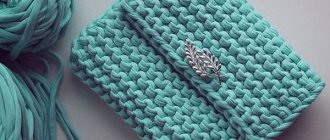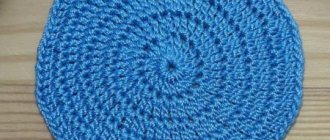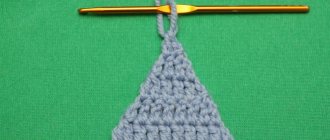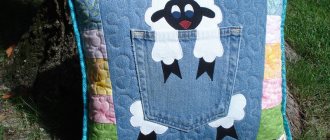In every family, over time there are many things that have become unusable. This includes children's clothing with stubborn stains, old T-shirts that have served their purpose, and jeans. But many thrifty housewives have found a way to breathe a second life into this rag. Crocheting rugs from leftover threads and rags, weaving them from various cords and ribbons, and making them using carpet-based techniques has become increasingly popular among them. Some methods for making such a home attribute are given later in the article.
Yarn preparation
Crocheting rugs from rags involves preliminary preparation of yarn from them.
It consists in:
- Choosing old things based on fabric structure that match each other.
- Cutting sorted raw materials into strips.
- Selecting ribbons by color (if necessary).
- Final preparation of yarn for knitting.
In order to correctly select the necessary material for making floor mats from rags, the first step is to sort it out and sort it by type of material. That is, put knitted items in one pile, denim in another, cotton in a third, synthetic in a fourth, and so on.
- After sorting the rags by fabric quality, you should prepare them for cutting. To do this, you need to trim all the seams, that is, along the bottom of the product and the sleeves.
- Next, lay the item on a hard surface and cut it into strips from one side seam to the parallel one, but not reaching it by 2-3 cm. This is necessary in order to create one continuous strip in the future.
- When performing this operation, you should know that it is recommended to cut dense fabric into narrow strips, and thin fabric into wider ones.
- After such a cut, in place of a continuous section of material, oblique cuts are made from one strip to the next, that is, the result should be a spiral-shaped continuous strip.
- If it breaks, it is advisable to sew the ends together by placing them on top of each other. Tying knots is not recommended. This will create inconvenience during further work and spoil the appearance of the finished product.
- After cutting the tape from very frayed fabrics, before winding it into a ball, it is advisable to treat its sections with fire. This technique will secure the cut threads and extend the life of the rug.
- The resulting yarn is wound into balls.
Oval woven from sheets
For this rug we will need the braids already seen above, we just need to make them tighter. To do this, we will need strips of sheets 5 cm wide and an oval frame made of thick fabric onto which we will sew our braids.
Stages of work:
- We fold each strip of sheet so that both cut parts are in the middle. Iron it.
- We fold each folded ribbon in half and iron it again.
- We divide the resulting braid into three strips and braid it into braids.
- Lay out the first braid in half in the center of the wide side, leaving space on the sides for braiding. We sew the braids together in the middle and tie them to the base with threads.
- We fly over the first layer of the rug, the second, the third, etc., until we fill the entire base.
- We grab the braids along the edges along with the base so that they hold well.
Simple round crochet rug
Crocheting rugs from round rags is not difficult if a person knows how to hold a hook in his hand and knows how to make two loops - a chain stitch and a single crochet stitch or just one stitch.
In order to avoid a hole in the center of the rug, experienced craftswomen recommend starting work with a ring of yarn formed by twisting it twice around the index finger. With this method, after knitting the first row of loops, it is convenient to eliminate the gap in the ring by tightening the end of the yarn remaining from the entanglement. Next, this remainder is hidden inside the knitted posts and cut off.
- After knitting the first row, it is closed by connecting the outer column to the first, pulling the captured working thread under the two arcs of the initial loop through the loop on the hook.
- Next, to complete the second row, you need to knit 2 lifting air loops. This technique prevents the canvas from skewing and also maintains its flat shape.
- Then knit the second row with the same single crochets. But in order to create the correct round, rather than domed, shape of the rug, you need to make 2 stitches in each subsequent loop of the previous row. Finish the row in the same way as the first.
Each subsequent circular row is knitted similarly to the one below, but to maintain the flat shape of the rug, additions must be made. Their number and frequency are calculated individually. This depends on the number of stitches in the first row, the thickness of the material used and the knitting density. With existing experience and skills, the need for additional loops is determined visually.
After reaching the desired diameter of the product, the outer row is closed, secured and the end of the yarn is hidden inside the knitted loops.
Round rug with braid
Another option for making a round rug is a combination of crocheting and sewing. This combined technique is used if the yarn is thick. It creates inconvenience during circular knitting. Therefore, to make such a rug, first a very long chain of air loops is knitted from prepared yarn. Then it is laid out evenly in a spiral, securing each subsequent turn with the previous one with a needle and thread. The result is a not too rough, but dense rug.
Products made from braids
Curling braids using a needle and pins is the simplest way to weave rugs from strips of fabric; it is useful for beginners to try it out. Three cuts of different colors are connected at the ends and begin to braid. The product is made up of one continuous braid, but it is inconvenient to weave strips that are too long.
Therefore, you will have to attach another tape each time as you work. The approximate suitable length is about half a meter, but the texture of the fabric, for example, matters (it’s easier to work with hard ones), in the process it will become clear which size is more convenient.
The next stage of weaving a rug from fabric strips, rolling the braid, can be started before it is completely ready. The tip of the tape is tucked in, secured on a flat surface and they begin to wind turn by turn in a spiral, forming a circle.
Each added turn is sewn to the previous one so that the product does not fall apart. This can be done as you fold, or pinned together first and stitched afterwards. If braids of equal length are laid out in a row, you will get a rectangular braided rug, in which case you will have to work hard to secure the free ends. The top side where the seams run will be the bottom and will be hidden under the lining needed for strength and shape retention.
Recommendation. If the weaving material is too thin to create the desired volume, the cuts can be made wide and folded in half.
Note!
How to make a craft with your own hands: what you can do with your own hands at home
DIY foam crafts: snowman, Christmas tree, sculptures, original figures with instructions (photo + video)
Papier mache from egg trays, boxes, cassettes: the best ideas on what can be made from egg packaging
Floor rug made of round motifs
One of the interesting solutions for making floor mats is various combinations of round fragments. They can be done:
- from the same material in structure, but different in color range;
- from fabrics of different composition and color;
- from several types of patterns.
The motifs can be connected to each other both when knitting the outermost row of each fragment, and after they are completely knitted. It depends on whether there is a preliminary layout of the elements or whether it is drawn up during the knitting process, how many and what sizes the parts are prepared.
Openwork rug
Crocheting rugs from rags using openwork hems has become quite a popular phenomenon in the interior of many homes. This is due to the fact that the “gaps” formed between the rows can be designed in a variety of ways. For example:
- You can stretch contrasting yarn or ribbon through the vertical constrictions;
- used to introduce finishing details in the form of leaves, flowers, ruffles, etc. into a standard pattern;
- During knitting, an LED cord can be inserted into some circular openwork rows. This will not only create coziness in the room, but will become an original addition to the interior.
For openwork rugs, it is recommended to use yarn of thin and medium thickness, since the finished product made from thick material will look awkward and rough.
Any pattern, as well as a diagram for its implementation, can be applied to floor mats. A wide variety of them can be found on the Internet. Round napkin patterns are also suitable for this. But too complex and ornate openwork should not be used.
Firstly, performing operations with a large number of loops will be difficult due to the thickness of the yarn.
Secondly, in places with a large number of posts or their combinations, compactions will be created, which will adversely affect the appearance of the finished product and will cause discomfort during direct use.
Below are some patterns for floor mats:
Patchwork and grass rugs
Nowadays carpets with long pile, called “grass”, are fashionable. They are very soft and warm. True, it’s difficult to clean them without a powerful vacuum cleaner, but they look beautiful and cozy with them. Making such rugs with your own hands is not at all difficult, however, it can take a lot of time. This is if you decide to use threads. But it's very beautiful.
These are the results that can be obtained using this technique. But to make the carpet so beautiful, you need ribbon yarn or thick threads
The idea is outrageously simple: threads and strips of fabric are tied to a mesh base. There are two tying techniques - just using a knot, and making a loop. They give slightly different results, but both techniques are good. You can try and choose.
How to make rugs with your own hands from scraps
The same painting mesh is suitable as a base, but a rubber anti-slip backing for carpets is better. She's practically perfect. We tie threads or scraps of the same length to the cells of the grid - in each or through one.
Row by row we tie the scraps
If you do not have such perseverance, but you have a sewing machine, the process can be speeded up significantly. But the base must be woven. We fold “blade of grass to blade of grass” and stitch it on a typewriter. So row after row. Making patchwork rugs with your own hands is much faster with a machine.
You can also use a rubber mat with holes as a basis.
In the form of a scarf
Crocheting rugs in the form of a scarf from rags can be done in 2 options:
- longitudinal,
- transverse
The difference between these methods is that when knitting longitudinally, you must immediately set the desired length, since it will not be possible to increase it later. With cross knitting this possibility exists. The same applies to the width of the product. It can be changed in the longitudinal direction, but not in the transverse direction.
Since the production of rectangular rugs involves straight and reverse rows, it is recommended to choose double-sided patterns for them, that is, so that they look the same on the front and back sides.
If knitting is carried out using the most common method, single crochets, then in order to avoid compactions between the rows, with each subsequent knitting, the working thread should be grabbed not under the two arcs of the lower loop, but only at the back one. Thus, smooth horizontal or transverse stripes (depending on the direction of knitting) are formed on the front and back sides, created by the remaining front arcs.
Rectangular rugs with square motifs
You can also create a beautiful floor rug using numerous multi-colored elements or fragments that differ in the structure of the material used.
Their knitting pattern can be either circular rows or straight or reverse. This depends on the thickness of the yarn used. For thinner source material, openwork patterns will be acceptable. Motifs from straight and reverse rows are better suited to dense raw materials. The size of the fragments is determined individually and depends on the required parameters of the finished product.
The coupling of motifs with each other can also be done in two ways: when knitting the outermost row and after making a complete set of parts. The connection of separately connected motifs is done by crocheting or sewing with a needle and thread.
Machine tools from other scrap materials
In addition to wood and plywood, weaving jigs of the above type can also be made from other materials. For example, from plastic pipes. When making miniature models, ordinary combs or cards are used. A photo of such a machine is presented above.
Also, when making miniature models, ordinary combs or cards are used. And the machine itself can be built from a cardboard box.
If you want to show your creativity even in the way of creating your own loom, go for it! You will succeed.
Nowadays you can buy almost all home craft products in stores. But sometimes you don’t have the money to buy it or you want to make something yourself. Recently, the variety of interiors has simply gone off scale. Designers often use antique items to create a unique and unique atmosphere in the home.
Many people cannot afford to hire a designer and purchase unusual decorative elements, so you can make such items yourself. For example, woven carpets will add color to the interior. And if they are made on their own, they will delight you every day. Moreover, with them your home will become cozy and warm. In addition to carpets, you can make napkins or lampshades. All these items are made using a loom.
All these things were made using a handloom. The first looms were large wooden structures. There were weaving looms in almost every house. And they were taught to use them from childhood. The skills of patterned weaving were passed down to the younger generation. Ancient looms were mostly shuttleless.
If you are interested in an activity such as weaving, then you can make a loom with your own hands at home. The loom is widely used in the modern world. The shuttleless table loom is also designated as STB. It is used in the processing of various fabrics to obtain finished products.
Pentagonal rug
A simple, but at the same time original solution is to make a pentagonal rug from an ordinary round rug. It is enough to make some calculations at the beginning of knitting. Before you begin making the first row around the starting ring, you should decide on the required number of loops, a multiple of 5. Depending on the thickness of the yarn, there can be 10, 15, and so on.
When knitting the second row, you should make constrictions from a certain number of air loops between the resulting five groups of loops. Their length is determined individually, based on the thickness of the material used.
When performing each subsequent circular row, do not forget about additionally adding loops in each first and final loop of a separate group. Their frequency is determined visually to avoid both the formation of a dome-shaped mat and the presence of tails.
After reaching the required diameter of the rug, the outer row is closed with a connecting post, the loop is secured, and the end of the yarn is hidden in the previously knitted rows.
How to make a machine from plywood or wood
If you have enough space to accommodate a full-fledged weaving device, it is worth trying to make a more professional model. Most often they are made from plywood or wood.
There are many ways to make such a device with your own hands.
There should be two rollers at the very beginning and at the end. Threads are wound onto one, and finished fabric onto the other. The ideal option is to make them with bolts or handles with the possibility of fixation.
If your machine does not have a separator that facilitates the slipping of the shuttle, you should first attach not 1, but 2 rollers. One will place the even warp threads, and the other will place the odd warp threads.
The last required detail is the reed. It can be made from 2 wooden planks with nails often driven between them.
When threading the machine, the threads will need to be passed between these teeth.
If all this is done correctly, you can get to work.
Based
Crocheting rugs from rags can also be done on a base. This technique for making rugs is called carpeting. It consists of filling the warp cells with pieces of yarn or strips of fabric. The result is a fluffy, soft rug with a pile of a certain length.
In order to knit such a rug, you need a special base. Due to the repeated use of the finished product, it must be strong and wear-resistant, so Stramin is used for such purposes. But due to its high cost and difficulty in acquiring, experienced craftswomen have found an excellent way out of this situation.
They suggest making the base for the rug yourself. For this you will need strong cotton threads. Next, depending on the shape of the intended rug, as well as the thickness of the material used, you should knit a mesh with identical cells. This can be a fabric of regular alternation of single crochets and 1 chain stitch, or a single crochet stitch and 2 chain loops.
In the case of knitting round rugs, it is necessary to introduce additional cells into the mesh so that the base maintains an even horizontal position. The size of the mesh base must be equal to the final parameters of the product.
After making the frame, it should be carefully treated with waterproof glue. In this case, you need to ensure that all the cells inside are not covered with adhesive film. Then let the base dry and you can start making the mat itself.
It should be noted that a special hook is designed for knitting products in carpet technology, which is a slightly curved tool with a closing head and a thick wooden handle. This hook structure is necessary for the convenience of gripping yarn or material under the warp and forming a fastening loop.
In addition to knitting the base for the rug, you should also pre-prepare the yarn. This process involves cutting identical pieces of leftover thread or strips of fabric. The length should not be less than 6-8 cm, since in addition to the pile, its consumption is used to make a fastening loop. There must be many of them, because one unit is used to cover one cell of the base grid.
The color scheme in this technique can be varied. By using multi-colored pieces of fabric, you will get a bright rug with an abstract pattern. If a more clear pattern or ornament is provided, then it is necessary to prepare material of the appropriate color scheme. To make a rug with a pattern, the preliminary preparation also includes a diagram of the pattern in boxes for the convenience of translating it into reality.
To get started, you need to take the hook and place it under the broach of the first cell. Fold the prepared strip of fabric in half and grab the resulting loop with a crochet hook. Pull it over the base, holding the ends. Pull the connected ends of the strip through the loop formed. Use your hand to pull up the resulting pile, while securing the loop to the base. Exactly the same operation should be performed with each subsequent cell. For convenience, it is recommended to knit from right to left.
By filling one row of cells after another in this way, you get a continuous, fluffy and very soft floor rug.
Factory machines
If you are wondering how to make a DIY loom, then you are one of those who want to create their own textile products from scratch. To do this, it is not necessary to make the machine yourself. You can buy it.
Read also: What are wrenches made of?
There are hundreds of varieties of factory-made looms on sale. Domestic or European manufacturers provide a guarantee for their products, so you can buy machines without fear that they will not be able to work.
Judging by the reviews, among Russian manufacturers the best are looms and Pelsi. The latter specializes in the manufacture of wooden toys.
As for manufacturers from other countries, their products are many times more expensive.
Made from denim
Due to the fact that denim fabric is quite dense and rough, it is recommended to make strips of it for knitting floor rugs as thin as possible. But the problem is that this material is very friable. During cutting, as well as twisting into balls, its structure quickly collapses and the strength of the prepared yarn is lost. To avoid such troubles, after cutting denim products into strips, it is advisable to treat their cuts with fire. The threads sintered along the edges for a long time prevent the yarn from shedding and create more comfortable conditions for working with it.
Due to its density, denim yarn is difficult to crochet. The best option for making a rug from this material would be to prepare a chain of air loops, crocheted, which will subsequently be assembled into a spiral and secured in layers.
Weaving loom for rugs
In addition to clothes, bed linen and towels, our grandmothers wove carpets and bedspreads on their looms. To create such products, the same classical devices were used. However, they are quite bulky. In addition, it takes a lot of time and effort just to thread the machine to start working on carpets.
Therefore, a simpler weaving device, the frame type, is very popular.
As a rule, rugs that are well known to all of us are created on such a machine from scraps of old clothes. You can also use special thick woolen threads.
How to make such a loom with your own hands? Quite simple. It is an improved version of the classic frame. However, it will be larger and longer. As fasteners for the base threads, you will have to use large nails or screws with thick legs and wide heads.
Pay attention to the special detail. You need to place 4 metal loops along the four edges of the machine. They are needed to fix 2 rods. When working on a rug, they will need to be inserted into its edges so that the width of the finished product is uniform.
Made from knitted fabric
Products made from knitted fabric are the most common and high-quality material for the manufacture of knitted floor rugs. It can be cut into strips of any width. The resulting yarn is soft, elastic, and durable. It does not crumble, but, when stretched, creates an even, twisted thread. When knitting from such yarn, very aesthetic and beautiful products are obtained.
Crocheting floor rugs from rags you don’t need in your wardrobe will help you not only gain handicraft skills, but also create additional comfort without financial expenses.











